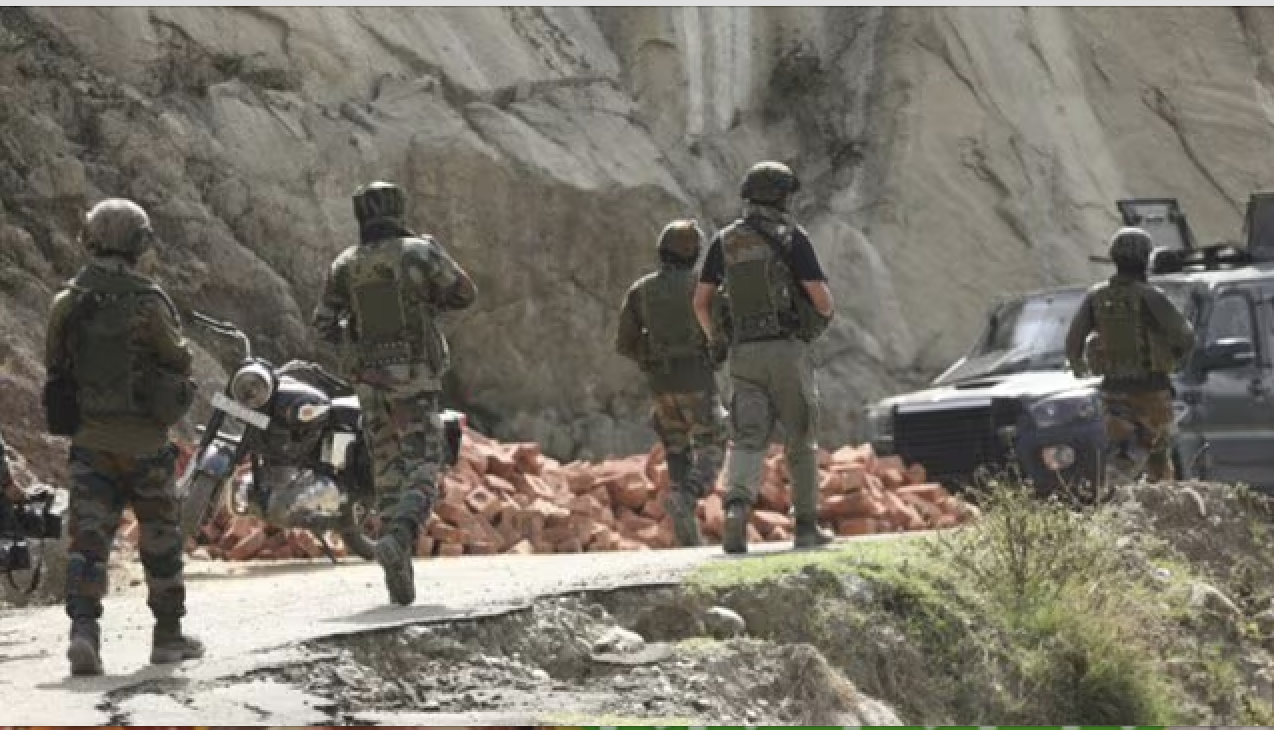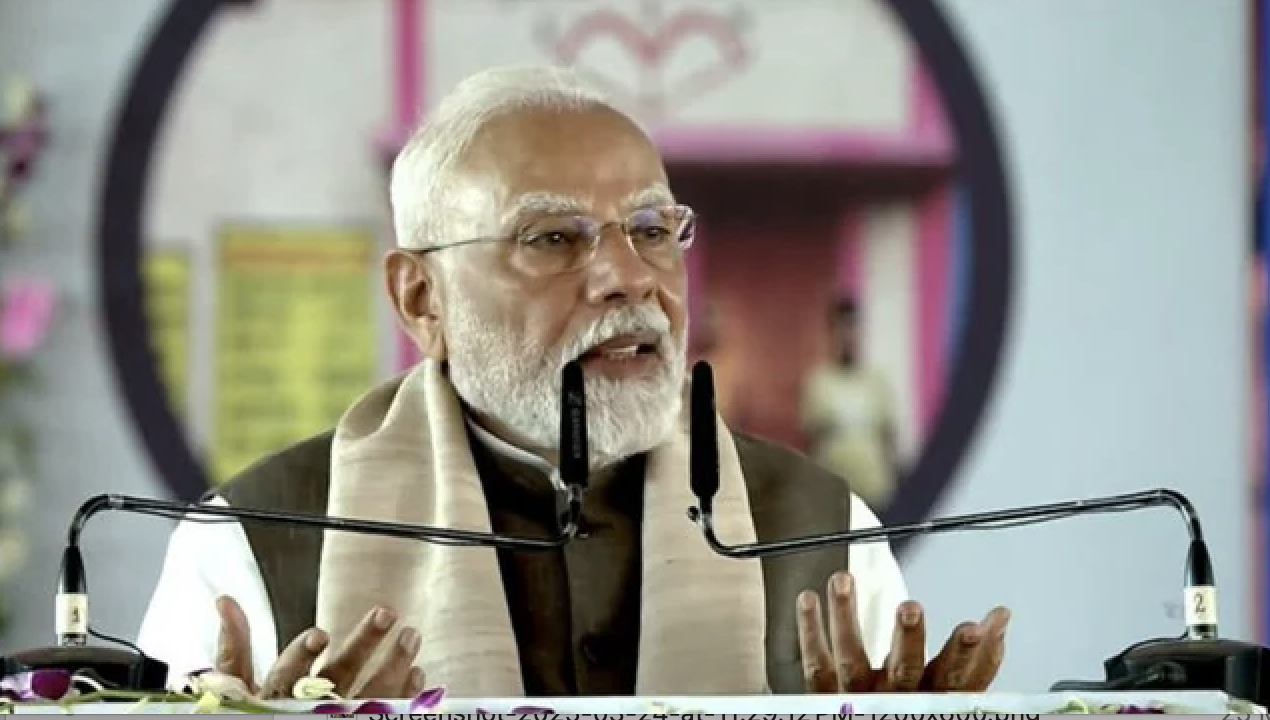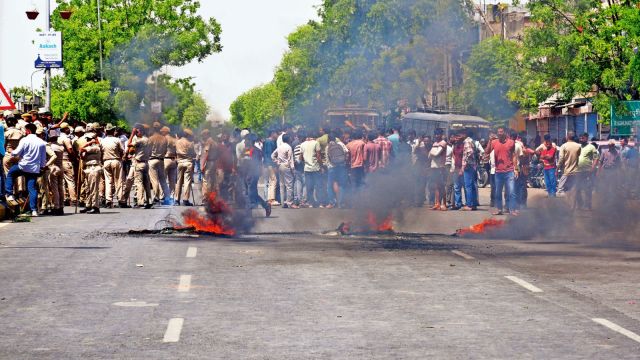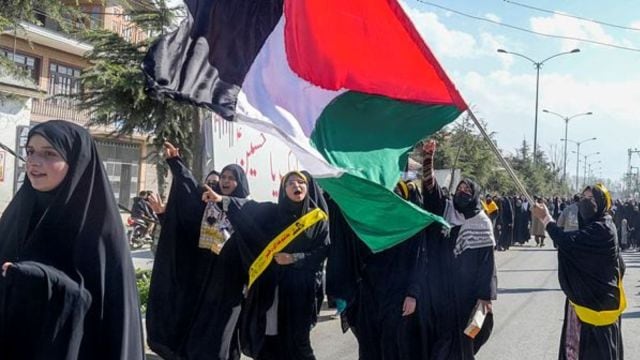The rise in anti-Muslim violence under Modi suggests that the demons of the country’s past are very much alive.

One day in June, towards the end of Ramadan, two young Muslim brothers on a visit to Delhi to buy new clothes for Eid boarded a train to return home, three hours away. Soon, they became embroiled in a disagreement over seating with fellow passengers, which escalated into an argument over their religion. The other passengers taunted the boys, calling them “beef-eaters,” and pulling at their beards, one of the brothers later said. Eventually, the knives came out. By the time the train had passed the boys’ village, the assault was underway. Fifteen-year-old Junaid Khan was thrown out of the carriage one station past the boys’ stop; he had been stabbed multiple times, and was later declared dead at Civil Hospital in Palwal.
Within days, thousands were flooding the streets of India’s cities in protests sparked by Junaid’s murder, led by Indians aghast at an ever-lengthening list of violent crimes committed by Hindu mobs. Lynching is an old crime here, often committed against those of so-called lower castes and marginalized tribes, in order to reinforce brutal social hierarchies. But dozens of news reports over the last two years indicate a dramatic rise in a specific kind of mob murder: the so-called “beef lynchings” of Muslims.
Of all the social fault lines caused by cultural and religious sensitivities surrounding food in India, none cut deeper than beef and beef-eating. Religious revivalism and political mobilization have exacerbated longstanding taboos on cow meat in many Hindu communities in modern India. Cow slaughter has long been illegal in most of the country—just this summer, new rules banning the sale of cattle for slaughter threw local meat and tannery industries, staffed and run in significant numbers by Muslims and people of marginalized castes, into disarray. So extreme was this proposal that India’s Supreme Court stayed the ban in mid-July.
These days, the specter of mob violence sparked by accusations that the victims slaughtered or smuggled cows or ate beef haunts India with morbid regularity. News of these killings usually proliferates through amateur videos, often filmed by members of the mob themselves. The phenomenon confirms, and perhaps even exceeds, the fears expressed by many critics of Prime Minister Narendra Modi and his Bharatiya Janata Party’s nationalist agenda, which they say is grounded not in bold economic reform, but in polarizing social conflict between Hindus and Muslims.
The pretext for this new wave of lynching extends beyond immediate accusations of beef-eating and other, more typical accusations, such as kidnapping and theft. If caste is the original sin of Indian society, Hindu-Muslim conflict, or “communalism,” as religious strife is called here, has had a distinctly modern character since the rise of Hindutva, the muscular, sentimental ideology of “Hindu-ness” that animates the BJP’s politics. Among other things, it normalizes a certain cultural-nationalist worldview which recasts the historic, 300-year rule of the Mughals (whose empire at one point stretched from Burma to Afghanistan and produced, among other things, the Taj Mahal and the Urdu language) as a form of Muslim settler-colonialism that oppressed Hindus.
This is a worldview in which the Partition of India in 1947 was part blessing, part treachery, a problem compounded by the fact that millions of Muslims in places such as Uttar Pradesh chose not to participate in the population exchange, taking their chances on the pluralist promises of independent India instead. Over the 70 years of the Indian republic’s existence, the right-wing organizations that see India’s Hindu-majority population as historical victims have opposed the country’s broad tendency towards social accommodation with vigorous, often-violent protest. Some of these organizations also gave birth to the BJP, which is why they are now as close to the seat of power as they have ever been.
In his masterful campaign in 2014, Modi’s focus on economic reforms impressed many who saw him as eschewing the brash majoritarian rhetoric that marked his years as a powerful regional leader. Free of the corruption scandals that wracked the Manmohan Singh government, Modi promised, India would march into an era of bold labor reforms, attract more foreign investment than ever, and ease regulatory chokeholds on business. There would be “minimum government,” he vowed, setting the hearts of entrepreneurs big and small aflutter, but “maximum governance.”
When you slaughter an animal, then the color of its meat is pink. This is what they call a “Pink Revolution.” [The central government] said with pride that, last year, India has earned the most from exporting meat. Across the countryside, our animals are getting slaughtered. Our livestock is getting stolen from our villages and taken to Bangladesh. Across India too, there are massive slaughterhouses in operation. And that’s not all. The Delhi sarkar will not give out subsidies to farmers or to Yadavs keeping cows but will give out subsidies to people who slaughter cows, who slaughter animals, who are destroying our rivers of milk, as long as they set up [slaughterhouses].Across India, the BJP’s victory seemed to embolden “cow protection” vigilantes, bands of men who claim to be motivated by their reverence for the animal. In the wake of “the Modi wave,” BJP-ruled states enacted legislation tightening existing anti-beef laws, clamping down on cattle sales and even the possession of beef.
Soon after seven Dalits (from India’s formerly marginalized castes) were flogged and humiliated for skinning a dead cow—a primary occupation for some of the victims—in Modi’s home state of Gujarat last year, the prime minister announced that he would rather be attacked himself than see violence against his Dalit brethren. With its plaintive note of self-sacrifice, his appeal was practically Gandhian.
But lynching is not ordinary, spontaneous violence, inflicted on the most conveniently available party. It is, historically, a ritual that explicitly enforces the outcaste status of its victims. It “combines the fellowship of a hunt with the honor of serving the alleged needs of the community,” as Fitzhugh Brundage wrote in his book, Lynching In The New South. Lynching’s particular vocabulary—the social air to its undertaking, the near-ceremonial bloodshed, the display of the mutilated body in triumph—belongs to the category of crime committed by men against those they see as property. As a punishment, it is a work of collective fiction: a gang of imagined victims wreaking vengeance on an imagined criminal in an inversion of the truth.
The rising prevalence of this medieval spectacle in India today is not just a symptom of ancient pathologies. It is the most spectacular outlet yet for Modi’s dog-whistle politics and the BJP’s Hindu-nationalist project. After his election victory, some of his critics noted that, even if he assumed a more statesmanlike demeanor, his party’s ethos would remain rooted in a form of social polarization that would help expand its Hindu base—and command its loyalty—at the expense of religious and inter-caste co-existence. Ashutosh Varshney, a political scientist at Brown University, has written that the BJP has too many voters who may be put off by large-scale rioting (historically a feature of social conflict in India). Instead, he predicted, social consolidation through violent means would be more easily managed by turning a blind eye to smaller-scale conflict, underwritten by the state’s own inaction and seeming bias. Sure enough, in the aftermath of these beef lynchings, police investigations have moved glacially; victims’ families are sometimes threatened with counter-charges of cow slaughter; political condemnation has been absent or lukewarm, if not outright tendentious. Assailed by criticism from the Indian parliament of the lynchings, a senior minister in Modi’s government said on July 21 that while there was “no justification” for the violence, opposition party workers advocating for beef-eating would have to understand that “by doing this they do as much damage to the country as the gau rakshak [or cow protector] on a train.”
On the ground, rural electrification and financial inclusion schemes have hardly been the key to social cohesion. In a critical report last month, The Economist noted that Modi was turning out to be a “nationalist firebrand” rather than an economic reformer. Employment is hard to guarantee in the country’s current, extended phase of jobless growth. Vast unregulated and unmonitored sections of its economy are still reeling from last November’s demonetization program, which overnight cancelled the value of more than three-quarters of the country’s banknotes in an attempt to curb corruption. Now, many agrarian communities are agitating for financial relief from crashing market prices.
It appears that an agenda against the Pink Revolution to prevent insults to the cow is easier to enact than a successful economic overhaul. In parts of northern India, Gau Raksha Dals, or “Cow Security Squads” are rampant, claiming to step in where the government abdicates its responsibility to protect the sacred animal. Shooting a WhatsApp video costs nothing—it quickly binds like-minded victimizers in religious solidarity. In states where law and order is subordinate to appeasing majority sentiments, Muslims grow easier to victimize than ever.
Through a period of what some are calling “beef terror,” Modi’s stance has largely been one of silence and seeming inaction. His feeble response to widespread anger over the death of Mohammed Ikhlaq, who was lynched in Uttar Pradesh in 2015, came eight days after the killing. Until recently, not one other instance of mob violence targeting a Muslim, whether on the pretext of beef or otherwise, seemed to merit the prime minister’s public attention. Following widespread protests after Junaid’s lynching, Modi delivered a tepid and generalized rebuke in a speech the week following Eid, this time invoking Gandhi directly. The father of the nation, he suggested, would have disapproved of murder in the name of cow worship. Meanwhile, an analysis of English news reports by the data portal IndiaSpend indicates at least 20 such “cow terror” attacks have occurred just this year; the study claimed at least 97 percent of the 63 attacks over an eight-year period occurred since the BJP assumed power.
For now, both Modi’s supporters and opponents understand his government, and those of his regional deputies in North India, to be firmly anti-Muslim. On the day of his speech, the mobs were at it again, beating another Muslim trader to death. The phenomenon has a acquired a certain viral character. In militarized Kashmir, around the time of Junaid’s death, an angry mob lynched a policeman who fired into the crowd at a mosque during an altercation. Both killers and victim were Muslims.
That video, said to have been secretly filmed by a police informer, was requisitioned and destroyed for the inflammatory nature of its violence. Still others live on, popping up on group texts and social media all over the country, every day. Like their principals, the watchers know, too, that there is power in this spectacle, strengthening the ethnic foundations of the India of Modi’s promises.
This story first appeared in TheAtlantic.com here.






